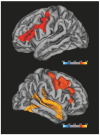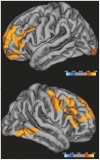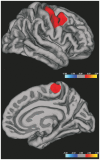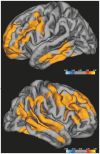Cortical thinning and clinical heterogeneity in amyotrophic lateral sclerosis
- PMID: 24278317
- PMCID: PMC3835750
- DOI: 10.1371/journal.pone.0080748
Cortical thinning and clinical heterogeneity in amyotrophic lateral sclerosis
Abstract
Amyotrophic lateral sclerosis (ALS) has heterogeneous clinical features that could be translated into specific patterns of brain atrophy. In the current study we have evaluated the relationship between different clinical expressions of classical ALS and measurements of brain cortical thickness. Cortical thickness analysis was conducted from 3D-MRI using FreeSurfer software in 29 ALS patients and 20 healthy controls. We explored three clinical traits of the disease, subdividing the patients into two groups for each of them: the bulbar or spinal onset, the higher or lower upper motor neuron burden, the faster or slower disease progression. We used both a whole brain vertex-wise analysis and a ROI analysis on primary motor areas. ALS patients showed cortical thinning in bilateral precentral gyrus, bilateral middle frontal gyrus, right superior temporal gyrus and right occipital cortex. ALS patients with higher upper motor neuron burden showed a significant cortical thinning in the right precentral gyrus and in other frontal extra-motor areas, compared to healthy controls. ALS patients with spinal onset showed a significant cortical thinning in the right precentral gyrus and paracentral lobule, compared to healthy controls. ALS patients with faster progressive disease showed a significant cortical thinning in widespread bilateral frontal and temporal areas, including the bilateral precentral gyrus, compared to healthy controls. Focusing on the primary motor areas, the ROI analysis revealed that the mean cortical thickness values were significantly reduced in ALS patients with higher upper motor neuron burden, spinal onset and faster disease progression related to healthy controls. In conclusion, the thickness of primary motor cortex could be a useful surrogate marker of upper motor neuron involvement in ALS; also our results suggest that cortical thinning in motor and non motor areas seem to reflect the clinical heterogeneity of the disease.
Conflict of interest statement
Figures





References
Publication types
MeSH terms
LinkOut - more resources
Full Text Sources
Other Literature Sources
Medical
Miscellaneous

